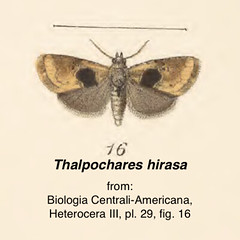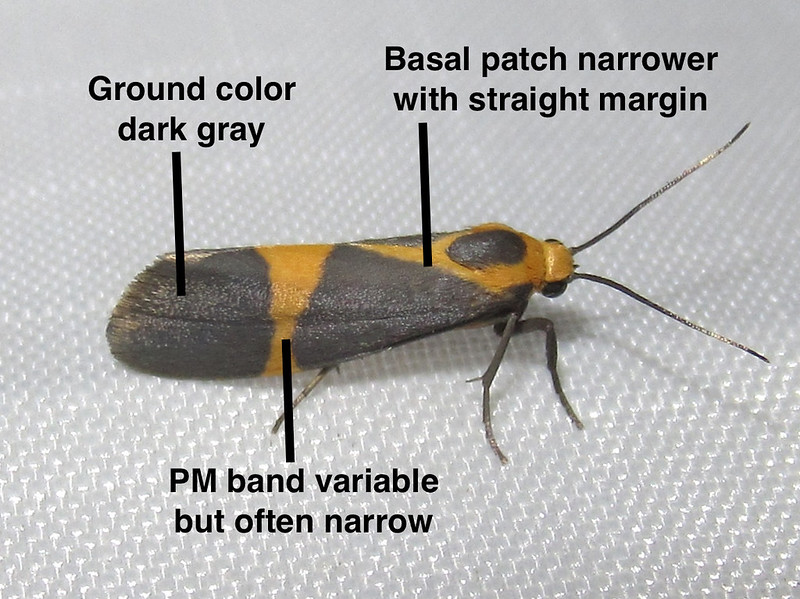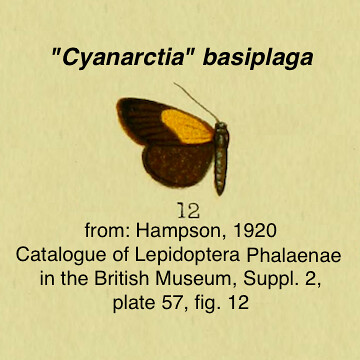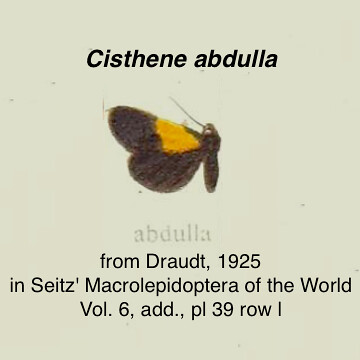Some Overlooked Tripudia Moths in Mexico
[An English version of this article follows the Spanish version, below.]
Resumen: Druce describió dos nuevas especies similares en el género Thalpochares en Biología Centrali-Americana en 1910: T. hirasa y T. idicra. Más recientemente, las dos especies han sido incluidas en el género Tripudia. Las especies parecen no haber sido reconocidas en el campo durante más de un siglo. Recientemente identifiqué varios ejemplos de las dos especies entre las observaciones de iNaturalist del oeste y sur de México.
Varias especies del género Noctuid Tripudia tienen cada una algún tipo de mancha dorsal rectangular o redondeado de color marrón oscuro en las alas anteriores. Los más extendidos y llamativos son la Tripudia quadrifera y Tripudia rectangula. Herbert Druce describió dos especies relacionadas con estas en el género Thalpochares en la Biología Centrali-Americana en 1910 (Vol. I, p. 314; Vol. III, pl. 29, figs. 15, 16): T. hirasa y T. idicra. Autores posteriores (Hampson, Draudt, etc.) las enumeraron en el género relacionado Cobubatha, pero más recientemente, las dos especies se trasladaron a Tripudia (FUNET).


Recientemente estaba tratando de ponerle un nombre a una polilla Tripudia no identificada de Sinaloa, México (publicada por @sinaloasilvestre), y noté la similitud con la distintiva "Thalpochares hirasa" de Druce:

Tripudia hirasa: Veranos, Sinaloa, México, Copyright @sinaloasilvestre
Posteriormente, encontré al menos otros ocho registros de esta polilla entre observaciones mexicanas que se remontan a 2017. Los registros provienen en su mayoría de Sinaloa, pero hay al menos un registro de Nayarit y otro registro probable de Baja California Sur. No he podido encontrar otras ilustraciones de esta especie ni otras imágenes en línea. Tripudia hirasa se puede reconocer por la mancha dorsal curva o en forma de maza, delineada de forma estrecha en blanco. La mancha se estrecha considerablemente en el lado distal en el margen interno del ala anterior, lo que le da a la mancha una forma general arqueada o de gancho.
En el curso de la búsqueda de más ejemplos de Tripudia hirasa en imágenes de iNat, noté un conjunto diferente de observaciones de México que coincidían con la descripción e ilustración de Druce en la BCA de "Thalpochares" [= Tripudia] idicra (misma página y enlaces de placas que arriba), y posteriormente encontró un total de siete observaciones que parecen coincidir con esa especie.

Tripudia idicra: cerca de Veranos, Sinaloa, México, Copyright @sinaloasilvestre
Otra vez, no puedo encontrar otras ilustraciones de T. idicra ni ninguna otra imagen en línea. Tripudia idicra aparentemente se distingue de T. hirasa por una mancha dorsal con márgenes blancos que es más grande y más redondeada, que se une ampliamente al margen interno del ala anterior, que no se estrecha como en T. hirasa. T. idicra suele tener un color marrón mucho más oscuro en el área posmediano más allá de la mancha dorsal; este área es generalmente de color marrón cremoso más pálido en T. hirasa. Hay otras diferencias menores en el patrón. Observaciones en iNaturalista de T. idicra son de los estados de Sinaloa, Nayarit y Guerrero, con otros registros en El Salvador y Costa Rica.
Summary: Druce described two similar new species in the genus Thalpochares in the Biologia Centrali-Americana in 1910: T. hirasa and T. idicra. Most recently, the two species have been placed in the genus Tripudia. The species seem to have gone unrecognized in the field for over a century. I recently identified several examples of the two species among iNaturalist observations from western and southern Mexico.
Several species of the Noctuid genus Tripudia each have some type of rectangular or rounded dark brown dorsal patch on the forewings. The most widespread and conspicuous of these are the Harp-winged Tripudia and Rectangular Tripudia. Two species related to these were described in the genus Thalpochares by Herbert Druce in the Biologia Centrali-Americana in 1910 (Vol. I, p. 314; Vol. III, pl. 29, figs. 15, 16): T. hirasa and T. idicra. Later authors (Hampson, Draudt, etc.) listed these in the related genus Cobubatha, but most recently, the two species have been moved to Tripudia (FUNET). [See original images from BCA, above.]
Recently I was trying to put a name to an unidentified Tripudia moth from Sinaloa, Mexico (posted by @sinaloasilvestre), and noted the similarity to Druce's distinctive "Thalpochares" hirasa. [See image above.] Subsequently, I found at least eight other records of this moth among Mexican observations going back to 2017. The records mostly come from Sinaloa, but there is at least one record from Nayarit and another probable record from the Baja California Sur. I have been unable to find any other illustrations of this species or other online images. Tripudia hirasa can be recognized by the curved or club-shaped dorsal patch which is narrowly outlined with white. The patch narrows considerably on the distal side at the forewing inner margin, giving the patch an overall arched or hook shape.
In the course of searching through iNat images for more examples of Tripudia hirasa, I noted a different set of observations from Mexico which matched Druce's description and illustration in the BCA of "Thalpochares" [= Tripudia] idicra (same page and plate links as above), and subsequently found a total of seven observations which seem to match that species. [See image above.] Again, I am unable to find any other illustrations of T. idicra nor any other online images. Tripudia idicra is apparently distinguished from T. hirasa by a white-margined dorsal patch which is larger and more rounded, meeting the forewing inner margin broadly, not indented as in T. hirasa. T. idicra usually has much more dark brown color in the postmedian area beyond the dorsal patch; this area is generally paler creamy-brown color in T. hirasa. There are other minor differences in pattern. iNaturalist observations of T. idicra are from the states of Sinaloa, Nayarit, and Guerrero, with other records in El Salvador and Costa Rica.





![Nyctochroa basiplaga Felder 1868 [1874] Voyage pl 106 f 27 copy](https://live.staticflickr.com/65535/53417444212_eb819057a8_w.jpg)






























